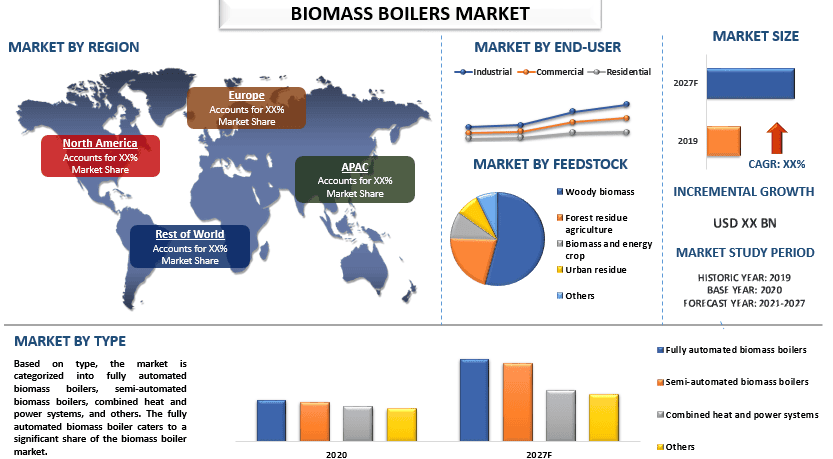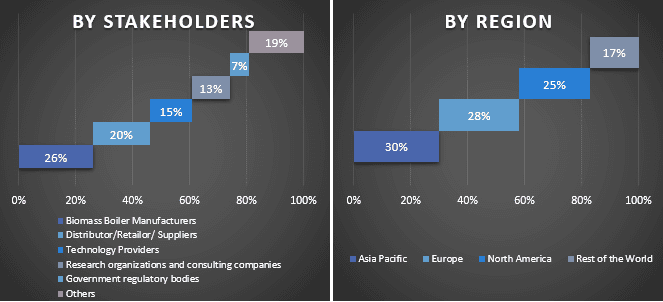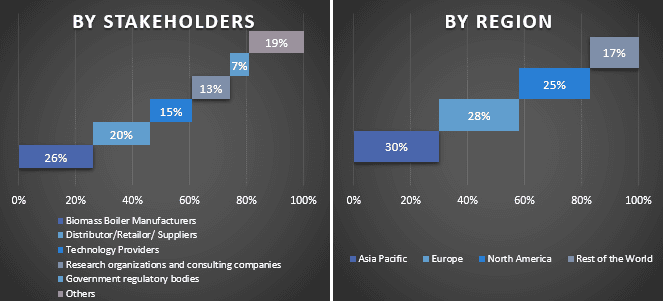Emphasis on Type (Fully Automated Biomass Boilers, Semi-Automated Biomass Boilers, Combined Heat, and Power Systems, and Others); Feedstock (Woody Biomass, Forest Residue Agriculture, Biomass and Energy Crop, Urban Residue, and Others); End-User (Residential, Commercial, and Industrial); and Region/Country

The Biomass Boiler Market is expected to grow at a CAGR of more than 7% during the forecasted period (2021-2027). This is mainly due to several government initiatives that seek to boost demand for renewable energy sources as a significant step toward reducing carbon emission levels. Additionally, government grants and regulatory frameworks offer tax breaks and investment incentives to various sectors of the economy that use renewable energy. This encourages biomass heating firms to transition to biomass at a higher level, which fuels market expansion.
Moreover, they produce less carbon dioxide, making them useful in a variety of applications, including district heating, commercial buildings, hospitals, farms, community centers, and domestic tasks. Biomass boilers provide an array of economic and environmental benefits owing to the renewable and low carbon nature of biomass. The market driver of the biomass boiler market is the renewable character of biomass boilers and government initiatives to support biodegradable products trigger market growth.
Some of the major players operating in the market include Alstom SA, Amec Foster Wheeler plc, Baxi (BDR Thermea), Thermax Limited, Hurst Boiler & Welding Co Inc., Innasol Ltd., WDS Green Energy Limited, ABIONOVA Hygiene Service GmbH, Babcock & Wilcox Enterprises Inc., and Dongfang Electric Corporation.
Insights Presented in the Report
“Amongst feedstock, wood biomass is expected to witness the highest CAGR during the forecast period”
Based on feedstock, the market is categorized into woody biomass, forest residue agriculture, biomass and energy crop, urban residue, and others. Woody biomass has a significantly larger share in the market, this is due to its ease of availability and low cost. woody biomass can help to mitigate greenhouse gas emissions, create healthier forests, and reduce the risk of wildfires. Therefore, these factors are escalating the adoption of woody biomass boilers in school systems, municipalities, and some commercial facilities as it improves air quality, visibility, and public health by reducing the smoke created by burning woody biomass.
“Amongst end-user, the industrial category is accounted for the majority share in the market in 2020”
Based on the end-user, the market is categorized into residential, commercial, and industrial. The industrial sector has a significant share in the market owing to its common use to form process steam, which helps to provide heating and cooling and generate electricity. The boilers are using biomass fuels as a substitute for fossil fuels like natural gas, coal, and fuel oil. Biomass-fired boilers are used at a time of an adequate source of biomass fuels exists in the manufacturing industry.
“Europe to witness significant growth during the forecast period”
Europe is expected to hold the largest growth rate in the global market during the forecast period. It is predominately due to the strict regulations taken by the government concerning greenhouse gas emissions. Additionally, the implementation of government schemes like renewable heating incentives (RHI) to lower the usage of fossil fuels is also expected to propel the growth of the biomass boiler market in the Europe region.
Reasons to buy this report:
Customization Options:
The global biomass boiler market can further be customized as per the requirement or any other market segment. Besides this, UMI understands that you may have your own business needs, hence feel free to connect with us to get a report that completely suits your requirements.
1. Market Introduction
2. Research Methodology Or Assumption
3. Market Synopsis
4. Executive Summary
5. Global Biomass Boiler Market Covid-19 Impact
6. Global Biomass Boiler Market Revenue (usd Bn), 2019-2027f
7. Market Insights By Type
8. Market Insights By Feedstock
9. Market Insights By End-user
10. Market Insights By Region
11. Biomass Boiler Market Dynamics
12. Biomass Boiler Market Opportunities
13. Biomass Boiler Market Trends
14. Policy & Regulatory Framework
15. Demand And Supply-side Analysis
16. Value Chain Analysis
17. Competitive Scenario
18. Company Profiled
19. Disclaimer
Research Methodology for the Global Biomass Boiler Market Analysis (2021-2027)
Analyzing the historical market, estimating the current market, and forecasting the future market of the global biomass boiler markets were the three major steps undertaken to create and analyze the adoption of Biomass boilers in major regions globally. Exhaustive secondary research was conducted to collect the historical market numbers and estimate the current market size. Secondly, to validate these insights, numerous findings and assumptions were taken into consideration. Moreover, exhaustive primary interviews were also conducted, with industry experts across the value chain of the global biomass boiler market. Post assumption and validation of market numbers through primary interviews, we employed a top-down/bottom-up approach to forecasting the complete market size. Thereafter, market breakdown and data triangulation methods were adopted to estimate and analyze the market size of segments and sub-segments of the industry pertains to. Detailed methodology is explained below:
Seek More Details About Research Methodology
Analysis of Historical Market Size
Step 1: In-Depth Study of Secondary Sources:
Detail secondary study was conducted to obtain the historical market size of the Biomass Boiler through company internal sources such as annual reports & financial statements, performance presentations, press releases, etc., and external sources including journals, news & articles, government publications, competitor publications, sector reports, third-party database, and other credible publications.
Step 2: Market Segmentation:
After obtaining the historical market size of Biomass Boiler, we conducted a detailed secondary analysis to gather historical market insights and share for different segments & sub-segments for major regions. Major segments are included in the report as type, feedstock, and end-use. Further country-level analyses were conducted to evaluate the overall adoption of testing models in that region.
Step 3: Factor Analysis:
After acquiring the historical market size of different segments and sub-segments, we conducted a detailed factor analysis to estimate the current market size of the Biomass Boiler. Further, we conducted factor analysis using dependent and independent variables such as type, feedstock, and end-use. A thorough analysis was conducted for demand and supply-side scenarios considering top partnerships, mergers and acquisitions, business expansion, and product launches in the Biomass Boiler sector across the globe.
Current Market Size Estimate & Forecast
Current Market Sizing: Based on actionable insights from the above 3 steps, we arrived at the current market size, key players in the global biomass boiler market, and market shares of the segments. All the required percentage shares split, and market breakdowns were determined using the above-mentioned secondary approach and were verified through primary interviews.
Estimation & Forecasting: For market estimation and forecast, weights were assigned to different factors including drivers & trends, restraints, and opportunities available for the stakeholders. After analyzing these factors, relevant forecasting techniques i.e., the top-down/bottom-up approach were applied to arrive at the market forecast about 2027 for different segments and sub-segments across the major markets globally. The research methodology adopted to estimate the market size encompasses:
Market Size and Share Validation
Primary Research: In-depth interviews were conducted with the Key Opinion Leaders (KOLs) including Top Level Executives (CXO/VPs, Sales Head, Marketing Head, Operational Head, Regional Head, Country Head, etc.) across major regions. Primary research findings were then summarized, and statistical analysis was performed to prove the stated hypothesis. Inputs from primary research were consolidated with secondary findings, hence turning information into actionable insights.
Split of Primary Participants in Different Regions

Market Engineering
The data triangulation technique was employed to complete the overall market estimation and to arrive at precise statistical numbers for each segment and sub-segment of the global biomass boiler market. Data was split into several segments & sub-segments post studying various parameters and trends in the areas of type, feedstock, and end-use in the global biomass boiler market.
The main objective of the Global biomass boiler market Study
The current & future market trends of the global biomass boiler markets were pinpointed in the study. Investors can gain strategic insights to base their discretion for investments on the qualitative and quantitative analysis performed in the study. Current and future market trends determined the overall attractiveness of the market at a regional level, providing a platform for the industrial participant to exploit the untapped market to benefit from a first-mover advantage. Other quantitative goals of the studies include:

Customers who bought this item also bought